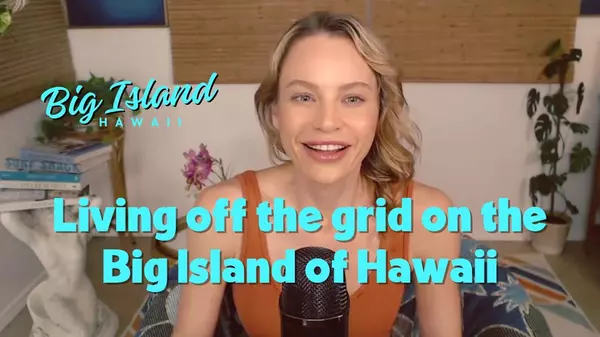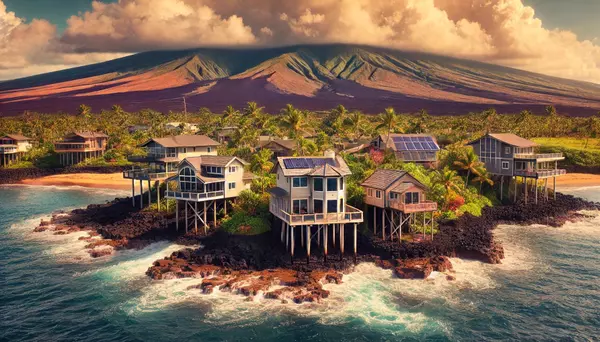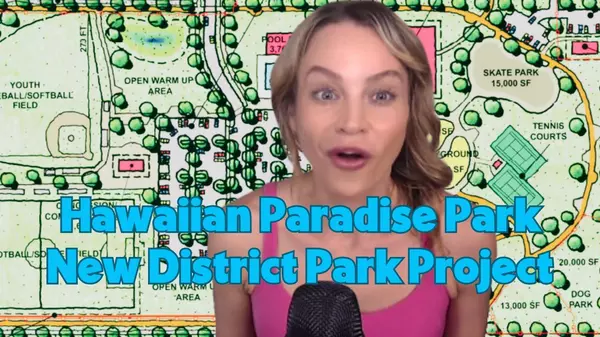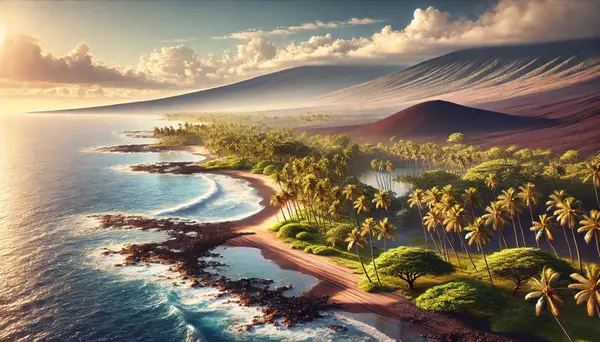
Embarking on an Off-Grid Adventure in Hawaii
The Dream of Island Off-Grid Living Have you ever found yourself daydreaming about escaping the hustle and bustle of city life to live on a tropical island? Imagine relying on solar power, rainwater, and growing your own food, all while enjoying a more relaxed lifestyle. It sounds like paradise, right? But before you make any big moves, let's dive into whether off-grid living on the Big Island of Hawaii is truly the dream lifestyle you've been imagining or if it comes with more than you bargained for. Understanding Off-Grid Living in Hawaii Living off the grid might sound romantic: a tiny home, solar panels, maybe some chickens wandering around your land. But what does "off-grid" really mean on the Big Island? It typically involves not being connected to the main utilities. You won’t have county water, traditional power grids, or curbside trash pickup. But don’t worry, this doesn’t mean a complete absence of modern conveniences. We're not talking about going full-on survivor mode (unless you want to, of course). You can still have a comfortable lifestyle with the right setup. Harnessing the Power of the Sun Going off-grid on the Big Island often means relying on solar power. Especially if you're on the sun-drenched west side in places like Kona, solar panels can power everything from your fridge to your Netflix sessions. But if you're in a rainier locale like Hilo, consider a backup generator to ensure you're never left in the dark. With advanced solar technology, it's entirely possible to maintain modern comforts and keep things running smoothly. Water: A Precious Resource One significant adjustment is switching to a rainwater catchment system for your water supply. It’s fully legal and works well with Hawaii’s climate, where rain is abundant in many areas. However, this means there’s no long, luxurious shower unless you embrace water conservation. If you're in drier regions like Kona, planning for the dry season is crucial, and sometimes, water deliveries become necessary. Dealing with Waste Without the Curbside Pickup Off-grid living means managing waste on your own. No curbside trash pickup here! Instead, you'll take your trash to the transfer station or, better yet, embrace composting. Composting isn’t just waste management; it's a vital part of growing your own food. Think of it as nature’s recycling system. Plus, it's quite rewarding to use your compost to nurture a garden overflowing with tropical fruits and vegetables that are otherwise pricey at the grocery store. The Joy of Growing Your Own Food One draw of off-grid living is the chance to cultivate your own fruits and veggies. The Big Island's climate is ideal for gardening, particularly in lush areas like Puna and Hilo. Planting and harvesting papayas, bananas, and avocados can quickly contribute to a self-sustaining lifestyle. However, be prepared to put in some work: plan your garden, tend to your soil, and protect your crops from eager pests and the occasional wild pig invasion. Off the Grid Composting Toilets Yes, a composting toilet might be in your future. While it might sound daunting, they’re more advanced and odor-free than you might think. If you're set on traditional conveniences, some off-grid properties offer conventional septic systems instead. Is Off-Grid Life Right for You? Off-grid living requires a specific mindset. You'll need to be comfortable maintaining various systems, planning for water and electricity needs, and embracing a hands-on lifestyle. If being self-sufficient and closer to nature appeals to you—and you're willing to put in the extra effort—this could be your dream lifestyle. Plus, you’ll gather plenty of tales to share, like when you’re asked what it’s like living with your solar panels and harvesting papayas right in your backyard. Consider if this lifestyle calls to you, and if it does, there’s no better place than the Big Island to pursue it. Whether you’re ready to jump into the off-grid life or just curious, reach out with questions and explore the properties available. Mahalo and Aloha! If this exploration into off-grid living intrigues you, like, share, and comment with your thoughts or questions. Let's connect and embark on this sustainable and independent living adventure together!

How Climate Change is Reshaping the Housing Market in 2024
In 2024, climate change isn’t just an abstract concept; it’s influencing where people choose to call home. A staggering 73% of homebuyers are factoring in climate risks like flooding, wildfires, and extreme temperatures when deciding where to buy. According to the Zillow Consumer Housing Trends Report, the majority of prospective buyers are more climate-conscious than ever before, seeking homes that stand up to the forces of nature. Let's explore the climate risks impacting homebuying decisions and what you should know to make a future-proof investment. Flood Zones: A Priority for Cautious Buyers Flooding tops the list of climate concerns for today's homebuyers, with 43% actively avoiding homes in flood-prone areas. With the increased likelihood of intense storms and heavy rainfall, the long-term financial impact of flood damage is a serious factor for prospective homeowners. FEMA’s online flood maps make it easy to assess whether a property lies in a flood zone. And even if flood insurance isn’t required, it might be a smart safeguard. Wildfire-Prone Regions: Safety in Flames In fire-prone areas, especially across the West, buyers are thinking twice. About 28% of homebuyers now avoid homes in regions with a high wildfire risk. Rising insurance costs and the devastation left by wildfires make these areas less appealing. For those considering homes in wildfire-prone areas, look for properties with fire-resistant materials—like flame-retardant roofing—and consider landscaping with wildfire-resistant plants for an extra layer of protection. Extreme Temperatures Are a Dealbreaker for Many With heatwaves and cold snaps on the rise, extreme temperatures are becoming a real concern. Twenty-six percent of homebuyers are choosing to avoid areas with harsh climates altogether. Energy efficiency is a top priority for these buyers, who want homes that provide comfort and sustainability. Features like modern insulation, energy-efficient windows, and advanced climate control systems make it easier to stay comfortable no matter the weather. Hurricanes and Coastal Risks: A Shifting Dream Living by the beach might sound dreamy, but 25% of buyers are steering clear of hurricane-prone areas. With rising coastal flooding and storm damage risks, buyers are prioritizing safety over the ocean view. For those still keen on coastal living, investing in hurricane-resistant features like impact windows, reinforced doors, and reliable homeowners insurance is essential to balancing dream with reality. Practical Tips for Climate-Conscious Buyers If natural disasters are on your radar as you look for a new home, you’re not alone. Here’s how to balance your dream of a safe, comfortable home with the growing realities of climate risk: Research Local Climate Risks Understand the specific risks in your chosen area, whether it’s flooding, fires, or extreme heat. Tools like FEMA’s flood maps and local government resources are a great starting point to make informed decisions. Invest in Climate-Resilient Features Homes with climate-resistant upgrades—like energy-efficient windows, efficient drainage, and impact-resistant structures—handle environmental challenges far better. These aren’t just nice perks; they can make a big difference in protecting your investment while potentially lowering insurance costs. Factor in Insurance Costs Early Climate risks like flooding or wildfire exposure often mean higher insurance premiums. Getting quotes early in the home search process will give you a clearer picture of total ownership costs, ensuring no unpleasant surprises. Choose a Location with Long-Term Appeal With climate risks set to increase, it’s wise to pick a location that’s likely to remain secure and stable. After all, your home should be a place of peace and security—a solid investment for you and your family. Climate-resilient home shopping doesn’t have to be overwhelming. By prioritizing the risks that matter most to you, you’ll find a safe, comfortable space you’ll be proud to call home for years to come.

Exciting Developments: Hawaiian Paradise Park's New District Park Project
Exciting news is buzzing in the Puna District of the Big Island! Particularly for those in Hawaiian Paradise Park (HPP), a long-awaited project is finally taking shape. This isn’t just a regular project; it’s a community-led initiative that could reshape the future of the area. If you’re eager to see how a community effort can spark transformative change, this is the project to follow closely! Hawaiian Paradise Park New District Park: A Game Changer The Hawaiian Paradise Park New District Park is generating a lot of anticipation—and for good reason. This massive 20-acre park, nestled between Kaloli Drive, 25th, and 26th Avenue, is set to serve not just HPP but the entire Puna District. The project, led by the County of Hawaii Department of Parks and Recreation, aims to promote healthy lifestyles and create a central gathering space for residents. From local families and athletes to even our four-legged friends, this park promises to be a game changer for everyone. And it's more than just a recreational space—it's a catalyst for community engagement and growth. A Long-Awaited Dream for HPP This isn’t an overnight success story. The master plan for this park dates all the way back to 1997. After years of community outreach, surveys, and public input, this dream is finally becoming a reality. For those who want a deeper dive into the full master plan, make sure to check out the link in the video description for all the detailed information! Features and Amenities: Something for Everyone What makes this park special? The range of features designed to cater to everyone. Here’s a sneak peek of what's to come: Sports Facilities: Expect baseball and softball fields, a football and soccer field (meeting high school standards), tennis courts, and the fast-growing favorite—pickleball courts. Yes, pickleball is taking over, and it’s awesome! Recreational Spaces: Get ready for a skate park, a community pool, and two covered playgrounds designed for keiki—one for younger kids (2-5 years old) and another for older kids. Multi-purpose Areas: A massive covered play court will house basketball and volleyball games, bleachers for fans, and even staff offices. Community Spaces: Enjoy picnic areas, a dog park for your furry companions, and a beautiful perimeter pathway perfect for walking, jogging, or just soaking in the island vibes. These amenities are designed to level up the recreational offerings for the whole community, especially since the nearest comparable park is a significant drive away in Pahoa. Construction Timeline and Community Input While the buzz around this park is real, we’ll need some patience. At a recent community meeting, it was revealed that the park’s completion is likely still about four years away. Why the wait? The County is navigating budget constraints, designing, permitting, and the construction process. The estimated cost for the project is over $80 million, but federal grants and state funding are being actively pursued to bring this dream to life. What’s great about this project is how deeply rooted it is in community input. Multiple public meetings and surveys have shaped the design, and more opportunities for feedback are on the horizon. In fact, an environmental assessment is expected soon, followed by a 30-day public comment period. Concerns like security (those pesky wild pigs) and environmental impact are top of mind, and the balance between accessibility and safety is key. How You Can Get Involved If this project excites you as much as it excites us, there are several ways to get involved and stay informed: Sign Up: Join the project's mailing list for the latest updates (you’ll find the link in the video description). Participate: Engage in upcoming community meetings to share your feedback and stay active in the conversation. Spread the Word: Share this blog post and the video with friends, family, or anyone in the HPP or Puna community who’s passionate about parks, recreation, and community building. Conclusion The Hawaiian Paradise Park District Park is set to be a game changer, bringing a vital asset to the community. While the timeline may require some patience, the impact will be worth the wait. Whether you’re excited about the pickleball courts (yes, it’s a thing now), the skate park, or the community gathering spaces, your engagement can help make this park even better. Don’t forget to watch the embedded YouTube video, subscribe for updates, and leave your thoughts in the comments section. What feature of this new park are you most excited about? Let us know! Mahalo for being part of this journey, and let’s continue to support this transformative project for the Puna District. Follow the project and get involved: https://ssfm.konveio.com/hpp-new-district-park
Categories
Recent Posts










